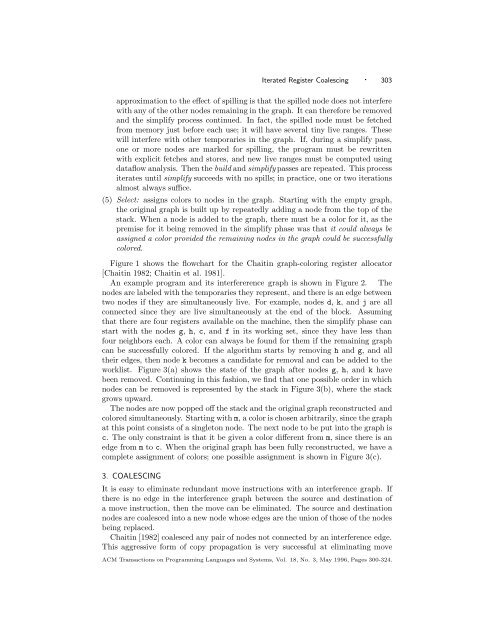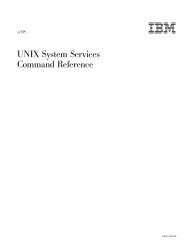Iterated Register Coalescing - School of Computer Science
Iterated Register Coalescing - School of Computer Science
Iterated Register Coalescing - School of Computer Science
Create successful ePaper yourself
Turn your PDF publications into a flip-book with our unique Google optimized e-Paper software.
<strong>Iterated</strong> <strong>Register</strong> <strong>Coalescing</strong> · 303approximation to the effect <strong>of</strong> spilling is that the spilled node does not interferewith any <strong>of</strong> the other nodes remaining in the graph. It can therefore be removedand the simplify process continued. In fact, the spilled node must be fetchedfrom memory just before each use; it will have several tiny live ranges. Thesewill interfere with other temporaries in the graph. If, during a simplify pass,one or more nodes are marked for spilling, the program must be rewrittenwith explicit fetches and stores, and new live ranges must be computed usingdataflow analysis. Then the build and simplify passes are repeated. This processiterates until simplify succeeds with no spills; in practice, one or two iterationsalmost always suffice.(5) Select: assigns colors to nodes in the graph. Starting with the empty graph,the original graph is built up by repeatedly adding a node from the top <strong>of</strong> thestack. When a node is added to the graph, there must be a color for it, as thepremise for it being removed in the simplify phase was that it could always beassigned a color provided the remaining nodes in the graph could be successfullycolored.Figure 1 shows the flowchart for the Chaitin graph-coloring register allocator[Chaitin 1982; Chaitin et al. 1981].An example program and its interfererence graph is shown in Figure 2. Thenodes are labeled with the temporaries they represent, and there is an edge betweentwo nodes if they are simultaneously live. For example, nodes d, k, andj are allconnected since they are live simultaneously at the end <strong>of</strong> the block. Assumingthat there are four registers available on the machine, then the simplify phase canstart with the nodes g, h, c, andf in its working set, since they have less thanfour neighbors each. A color can always be found for them if the remaining graphcan be successfully colored. If the algorithm starts by removing h and g, andalltheir edges, then node k becomes a candidate for removal and can be added to theworklist. Figure 3(a) shows the state <strong>of</strong> the graph after nodes g, h, andk havebeen removed. Continuing in this fashion, we find that one possible order in whichnodes can be removed is represented by the stack in Figure 3(b), where the stackgrows upward.The nodes are now popped <strong>of</strong>f the stack and the original graph reconstructed andcolored simultaneously. Starting with m, a color is chosen arbitrarily, since the graphat this point consists <strong>of</strong> a singleton node. The next node to be put into the graph isc. The only constraint is that it be given a color different from m, since there is anedge from m to c. When the original graph has been fully reconstructed, we have acomplete assignment <strong>of</strong> colors; one possible assignment is shown in Figure 3(c).3. COALESCINGIt is easy to eliminate redundant move instructions with an interference graph. Ifthere is no edge in the interference graph between the source and destination <strong>of</strong>a move instruction, then the move can be eliminated. The source and destinationnodes are coalesced into a new node whose edges are the union <strong>of</strong> those <strong>of</strong> the nodesbeing replaced.Chaitin [1982] coalesced any pair <strong>of</strong> nodes not connected by an interference edge.This aggressive form <strong>of</strong> copy propagation is very successful at eliminating moveACM Transactions on Programming Languages and Systems, Vol. 18, No. 3, May 1996, Pages 300-324.









